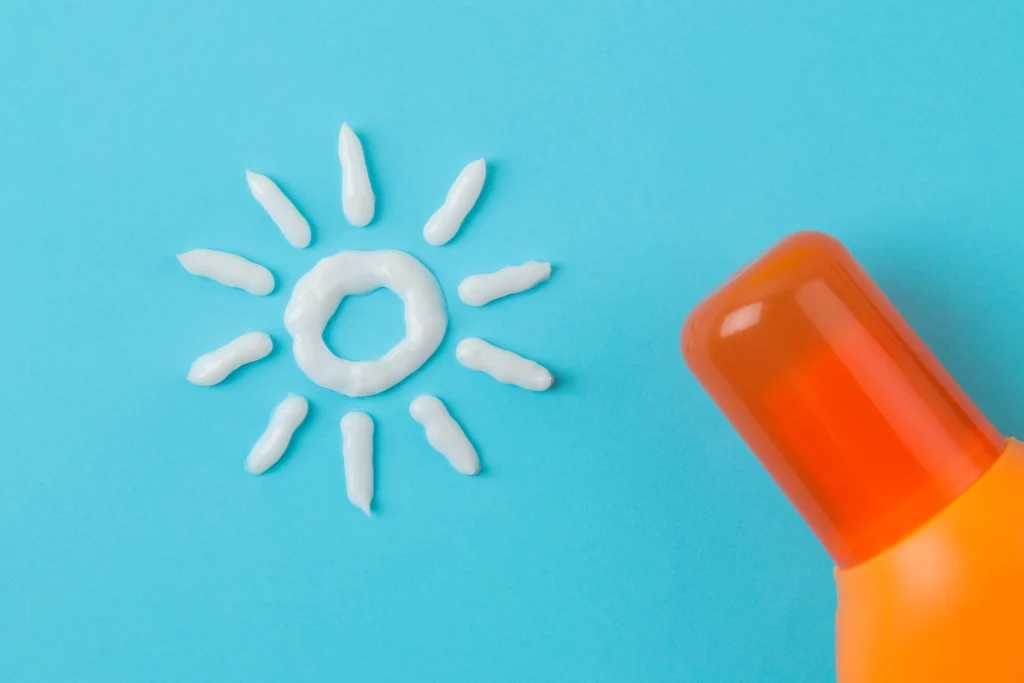
Whether you’re a daily commuter, a beach enthusiast, or someone with sensitive skin, you should wear sunscreen!
But navigating the vast sea of sun protection options can feel overwhelming.
That’s why we go into the specifics of chemical versus mineral sunscreens, dissecting how each type interacts with your skin and the sun’s rays.
You’ll also learn about the active ingredients that make up these formulations and how they contribute to your skin’s defence against UVA and UVB radiation.
Sunscreen Fundamentals
To find the ideal sun protection, you need to understand the different types of sunscreens available, their ingredients, and their level of protection.
Chemical vs Mineral Sunscreens
Choosing the right sunscreen type is important to achieve effective sun protection. Below, we’ll break down the two main types of sunscreen: chemical and mineral.
Chemical sunscreens, which include active ingredients like avobenzone, homosalate, octisalate, and octocrylene, work by absorbing UV rays and converting them into heat that is then released from the skin.
On the other hand, mineral sunscreens, also known as physical sunscreens, contain active minerals, primarily titanium dioxide and zinc oxide, which act as a physical barrier that reflects UV radiation away from the skin.
Since they are not absorbed, these ingredients are often recommended for sensitive, dry, or acne-prone skin.
Titanium dioxide and zinc oxide are recognized as safe and effective at protecting against both UVA and UVB rays.
UVA and UVB Rays
UVA and UVB rays are two types of ultraviolet (UV) radiation emitted by the sun that reach the earth’s surface and have various effects on the skin.
- UVA Rays: These rays have a longer wavelength and can penetrate deeper into the skin’s layers. UVA rays are primarily associated with skin ageing, causing damage such as wrinkles, leathery skin, and age spots. They can also contribute to the development of skin cancer. UVA rays are present with relatively equal intensity during all daylight hours throughout the year and can penetrate clouds as well as glass.
- UVB Rays: UVB rays have a shorter wavelength and are the main cause of sunburn. They are also a significant factor in the development of skin cancer. The intensity of UVB rays varies by season, location, and time of day, with the highest levels occurring during the summer months, in tropical areas, and around midday.
Both types of UV radiation can damage the skin and lead to skin cancer. Broad-spectrum sunscreen products are formulated to protect against both UVA and UVB rays.
SPF and Protection Levels
The SPF (Sun Protection Factor) indicates the theoretical amount of time you can spend in the sun without getting sunburned.
For instance, an SPF of 30 would allow you to stay in the sun 30 times longer than without protection. However, high SPF sunscreens should be reapplied every two hours for effective protection.
Benefits of Mineral Sunscreens

Mineral sunscreens are known for being non-comedogenic (won’t clog pores) and offering protection against both UVA and UVB rays, often referred to as broad-spectrum protection.
They are less likely to cause skin irritation, which greatly benefits those with sensitive skin. Furthermore, mineral sunscreens start protecting you immediately upon application.
6 Reasons to Choose Mineral Sunscreen Over Chemical Sunscreen
Considering the increased awareness of what we apply to our skin and its impact on the environment, mineral-based sunscreens offer a compelling choice.
From immediate protection to better suitability for sensitive skin types, here are six reasons why you should choose mineral over chemical sunscreen:
- Broad-Spectrum Protection: Mineral sunscreens provide broad-spectrum protection against both UVA and UVB rays as they sit on top of the skin and reflect the sun’s rays away from the skin.
- Are Non-comedogenic: Mineral sunscreens often have the additional benefit of being non-comedogenic, meaning they are formulated not to clog pores. Their active ingredients (zinc oxide and titanium dioxide) sit on top of the skin rather than being absorbed into it. Moreover, these minerals have a larger particle size than many chemical sunscreen ingredients, reducing the likelihood of them penetrating deep into the pores and causing blockages.
- Immediate Effectiveness: Mineral sunscreens are effective as soon as they’re applied to the skin. Unlike chemical sunscreens, which usually require about 15 minutes to absorb and start working.
- Less Irritation for Sensitive Skin: Because they contain natural minerals and do not absorb into the skin, mineral sunscreens are often less irritating for those with sensitive skin or conditions like rosacea or acne.
- Reef Safe: Some chemical sunscreen ingredients have been found to harm marine life and coral reefs. Mineral sunscreens are generally considered safer for marine life, making them a preferred choice for environmentally conscious consumers.
- Water Resistance: Mineral sunscreens are also known for their water-resistant properties, making them ideal for water-related activities like swimming.
Additional Things to Keep in Mind About Mineral Sunscreen
- White Cast: Mineral sunscreens can sometimes leave a white cast on the skin, especially on deeper skin tones. However, formulations have improved significantly, and many mineral sunscreens now offer a sheer finish.
- Application: Mineral sunscreens can sometimes feel thicker than chemical sunscreens.
How to Choose the Right Mineral Sunscreen
Mineral sunscreens are a fantastic choice for their gentle and effective protection. But even within this category, there’s a diverse range of options tailored to different skin concerns.
Whether you have sensitive skin, oily skin, or something in between, there’s a mineral sunscreen for you!
Let’s look at a couple of mineral sunscreens, each tailored to suit different skin types.
Oily Skin
For those with oily skin, finding a product that controls shine without clogging pores is essential. A mineral sunscreen with a matte finish can provide the protection you need while keeping that excess sheen in check.
The EltaMD UV Clear Broad-Spectrum SPF 46 is an excellent example of an oil-free, fragrance-free, and non-comedogenic option that leaves a matte finish, making it ideal for oily skin types.

Sensitive Skin
Sensitive skin requires a gentle touch, and sunscreens that are free from fragrances and packed with soothing ingredients can help prevent irritation.

The La Roche-Posay Anthelios Mineral Zinc Oxide SPF 50 is a standout choice for sensitive skin. It offers a fragrance-free formula that includes antioxidants to defend against oxidative stress from UV exposure.
Combination Skin
Combination skin can be tricky, as it needs a balance between hydration and oil control. A lightweight, non-greasy mineral sunscreen will provide the necessary sun protection without disrupting the skin’s natural balance.
The Neutrogena Ultra Sheer Dry-Touch Sunscreen SPF 55 is a great oil-free and non-comedogenic option that absorbs quickly for a clean, non-greasy finish, ideal for combination skin.

How to Apply Mineral Sunscreen
Mineral sunscreens offer fantastic sun protection, but their thicker consistency can sometimes feel tricky to apply compared to chemical sunscreens.
Here’s a guide on how to apply it:
- Shake Well: Give the sunscreen bottle a good shake to ensure even distribution, especially if it’s a formula that can separate.
- Use Sufficient Amount: You’ll need about an ounce (or a shot glass full) of sunscreen to cover the entire body. Make sure to apply a generous layer to all exposed skin.
- Dot, Dab, & Spread (Face): For the face, use a “dab and dot” technique. Apply small dots of sunscreen to your forehead, cheeks, nose, and chin. Then, gently rub each dot in using a circular motion until evenly distributed. Be careful around the eyes – apply a thin layer to the brow bone, avoiding direct contact with the eye itself.
- Rub In Thoroughly: Unlike chemical sunscreens, mineral sunscreens work by physically blocking UV rays. This means you need to rub the sunscreen in to ensure good coverage and allow the particles to better adhere to your skin. Feel free to use a bit more pressure than you might with a chemical sunscreen, but avoid harsh scrubbing.
- Reapply Regularly: Mineral sunscreen should be reapplied every two hours or more frequently if you’re swimming, sweating, or towel-drying.